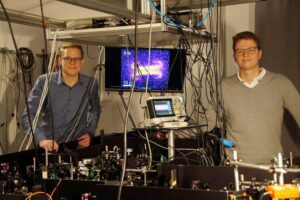Ultrafast video camera for electric fields

Ultrafast terahertz microscopy uses luminous nanocrystals to visualize near-field electric fields.
Credit: Moritz Heindl / Universität Bayreuth
From Heinrich Hertz to Terahertz:
Today, high-tech applications in optoelectronics work with ultrafast electrical oscillations, reaching frequencies up to the terahertz range. A team from the Universities of Bayreuth and Melbourne has now succeeded in developing a microscope that records videos of these oscillations. The glow of semiconductor nanocrystals makes visible the previously hidden electric fields that drive ultrafast electrical components. The researchers present their discovery in the journal Light: Science & Applications. The microscope could be used to observe the driving fields of nanocircuits in operation.
The human eye detects the intensity of light, but does not register the underlying electric fields. It was not until 1886 that Heinrich Hertz was able to prove their existence by making atoms glow through electromagnetic waves. However, the temporal waveforms, which are widely used today in fast electrical circuits, remained hidden from the eye. Scientists at the Universities of Bayreuth and Melbourne are now making them visible in a microscope for the first time. For this purpose, they use semiconductor nanocrystals consisting of few thousand atoms, which are referred to as quantum dots in research. The crucial factor here is the fluorescence of the quantum dots: They are deposited on a surface structured in the micrometer range and form a coating that reacts sensitively to electric fields – in such a way that the fluorescence signals of the quantum dots change. In the microscope, samples of the coated surface are now excited by terahertz electric fields and scanned immediately afterwards with femtosecond laser flashes. The resolution is extremely high: a single oscillation of the electric field with a frequency of one trillion Hertz can be registered in this way and converted into an optical signal. One trillion hertz corresponds to one terahertz (1 THz).

Photo: AG Herink / Universität Bayreuth
With the new microscope, the team in Bayreuth and Melbourne has succeeded in recording a video of the electric fields inside a terahertz antenna – a so-called bowtie resonator. These antennas are at the heart of THz radio links and enable broadband amplification of ultrafast signals. At the University of Bayreuth, they are being further developed in collaboration with the research group of Prof Dr Markus Retsch (Physical Chemistry). “We image the field distributions in this terahertz antenna far below the diffraction limit, namely with the resolution of a hundredth of the THz wavelength. In principle, our method allows for even a much higher resolution. It can be significantly refined by highest resolution fluorescence microscopy. With this goal in mind, we will continue to work closely with the Australian research group led by Prof. Dr. Paul Mulvaney,” says the Bayreuth doctoral student and first author of the study, Moritz Heindl M.Sc.
With regard to future technological applications, the new “field microscope” is particularly interesting because it is now possible to track the excitation and propagation of highly localized THz wave packets on complex surface structures. “This opens up new possibilities for accelerating future microelectronics. Linear and nonlinear effects in tailored semiconductor material systems can be used to specifically shape microscopic fields and process signals in an ultrafast fashion,” says the study’s leader, Prof. Dr. Georg Herink, Junior Professor of Ultrafast Dynamics at the University of Bayreuth.
Wissenschaftliche Ansprechpartner:
Prof. Dr. Georg Herink
Ultrafast Dynamics
Phone: +49 (0)921 / 55-3161
E-mail: georg.herink@uni-bayreuth.de
Fax: +49 (0)921 / 55-3802
Originalpublikation:
Media Contact
All latest news from the category: Physics and Astronomy
This area deals with the fundamental laws and building blocks of nature and how they interact, the properties and the behavior of matter, and research into space and time and their structures.
innovations-report provides in-depth reports and articles on subjects such as astrophysics, laser technologies, nuclear, quantum, particle and solid-state physics, nanotechnologies, planetary research and findings (Mars, Venus) and developments related to the Hubble Telescope.
Newest articles

Innovative 3D printed scaffolds offer new hope for bone healing
Researchers at the Institute for Bioengineering of Catalonia have developed novel 3D printed PLA-CaP scaffolds that promote blood vessel formation, ensuring better healing and regeneration of bone tissue. Bone is…

The surprising role of gut infection in Alzheimer’s disease
ASU- and Banner Alzheimer’s Institute-led study implicates link between a common virus and the disease, which travels from the gut to the brain and may be a target for antiviral…

Molecular gardening: New enzymes discovered for protein modification pruning
How deubiquitinases USP53 and USP54 cleave long polyubiquitin chains and how the former is linked to liver disease in children. Deubiquitinases (DUBs) are enzymes used by cells to trim protein…


